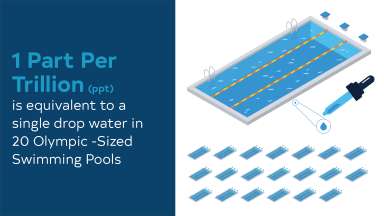On April 10, the Environmental Protection Agency finalized a national drinking water standard. This standard will manage the level of per-and polyfluoroalkyl substances, which are often abbreviated to “PFAS.” Take a look at the FAQs below to learn more about what PFAS is and what this means for water services provided by Raleigh Water.
What are Per-and Polyfluoroalkyl Substances (PFAS)?
Simply put, PFAS are a group of human-made chemicals. To learn more about where PFAS can be found, health impacts, and other information, view the Understanding PFAS page from the NC Department of Environmental Quality.
PFAS and Raleigh Water
Are regulated Per-and Polyfluoroalkyl Substances (PFAS) in my drinking water?
Yes. Per-and Polyfluoroalkyl Substances and Perfluorooctanoic Acid have been detected in our untreated water and in some cases our treated drinking water.

The concentrations of these compounds are very low and expressed in parts per trillion, which is equivalent to one single drop of water in twenty olympic-sized swimming pools.
Does Raleigh Water test for Per-and Polyfluoroalkyl Substances (PFAS)?
Yes! Raleigh Water tests quarterly for the regulated PFAS compounds as prescribed by the Safe Drinking Water Act. This data can be found on our PFAS landing page.
Will my water bill increase because of these updated regulations?
At this time, there is no impact to utility bills. However, we are continuing to evaluate advanced treatment technologies that if required in the future could result in an increase to our customer’s utility bills.
What is Raleigh Water doing to meet the new regulations for PFAS?
Raleigh Water has been optimizing our existing treatment system in order to meet the new PFAS regulations. During the most recent sampling event, all PFAS compounds were under detection limits. Raleigh Water will continue to monitor for PFAS and evaluate new treatment technologies to further enhance our treatment process.
When do the new regulations go into effect?
The updated regulations were announced on April 10, 2024. Public water systems have five years (by 2029) to implement solutions to reduce PFAS as needed.
